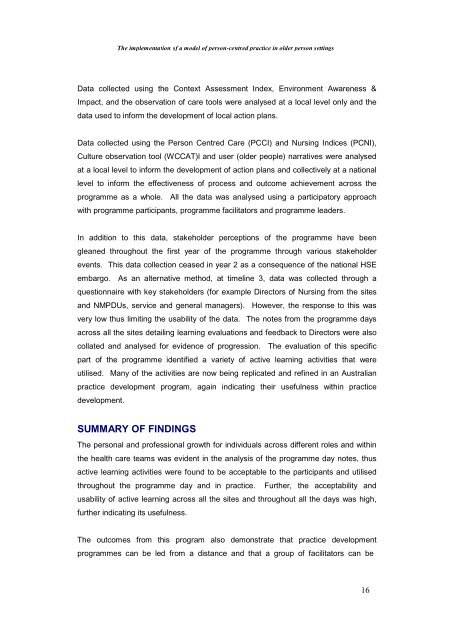The Implementation of a Model of Person-Centred Practice In Older ...
The Implementation of a Model of Person-Centred Practice In Older ...
The Implementation of a Model of Person-Centred Practice In Older ...
Create successful ePaper yourself
Turn your PDF publications into a flip-book with our unique Google optimized e-Paper software.
<strong>The</strong> implementation <strong>of</strong> a model <strong>of</strong> person-centred practice in older person settings<br />
Data collected using the Context Assessment <strong>In</strong>dex, Environment Awareness &<br />
Impact, and the observation <strong>of</strong> care tools were analysed at a local level only and the<br />
data used to inform the development <strong>of</strong> local action plans.<br />
Data collected using the <strong>Person</strong> <strong>Centred</strong> Care (PCCI) and Nursing <strong>In</strong>dices (PCNI),<br />
Culture observation tool (WCCAT)l and user (older people) narratives were analysed<br />
at a local level to inform the development <strong>of</strong> action plans and collectively at a national<br />
level to inform the effectiveness <strong>of</strong> process and outcome achievement across the<br />
programme as a whole. All the data was analysed using a participatory approach<br />
with programme participants, programme facilitators and programme leaders.<br />
<strong>In</strong> addition to this data, stakeholder perceptions <strong>of</strong> the programme have been<br />
gleaned throughout the first year <strong>of</strong> the programme through various stakeholder<br />
events. This data collection ceased in year 2 as a consequence <strong>of</strong> the national HSE<br />
embargo. As an alternative method, at timeline 3, data was collected through a<br />
questionnaire with key stakeholders (for example Directors <strong>of</strong> Nursing from the sites<br />
and NMPDUs, service and general managers). However, the response to this was<br />
very low thus limiting the usability <strong>of</strong> the data. <strong>The</strong> notes from the programme days<br />
across all the sites detailing learning evaluations and feedback to Directors were also<br />
collated and analysed for evidence <strong>of</strong> progression. <strong>The</strong> evaluation <strong>of</strong> this specific<br />
part <strong>of</strong> the programme identified a variety <strong>of</strong> active learning activities that were<br />
utilised. Many <strong>of</strong> the activities are now being replicated and refined in an Australian<br />
practice development program, again indicating their usefulness within practice<br />
development.<br />
SUMMARY OF FINDINGS<br />
<strong>The</strong> personal and pr<strong>of</strong>essional growth for individuals across different roles and within<br />
the health care teams was evident in the analysis <strong>of</strong> the programme day notes, thus<br />
active learning activities were found to be acceptable to the participants and utilised<br />
throughout the programme day and in practice. Further, the acceptability and<br />
usability <strong>of</strong> active learning across all the sites and throughout all the days was high,<br />
further indicating its usefulness.<br />
<strong>The</strong> outcomes from this program also demonstrate that practice development<br />
programmes can be led from a distance and that a group <strong>of</strong> facilitators can be<br />
16
















